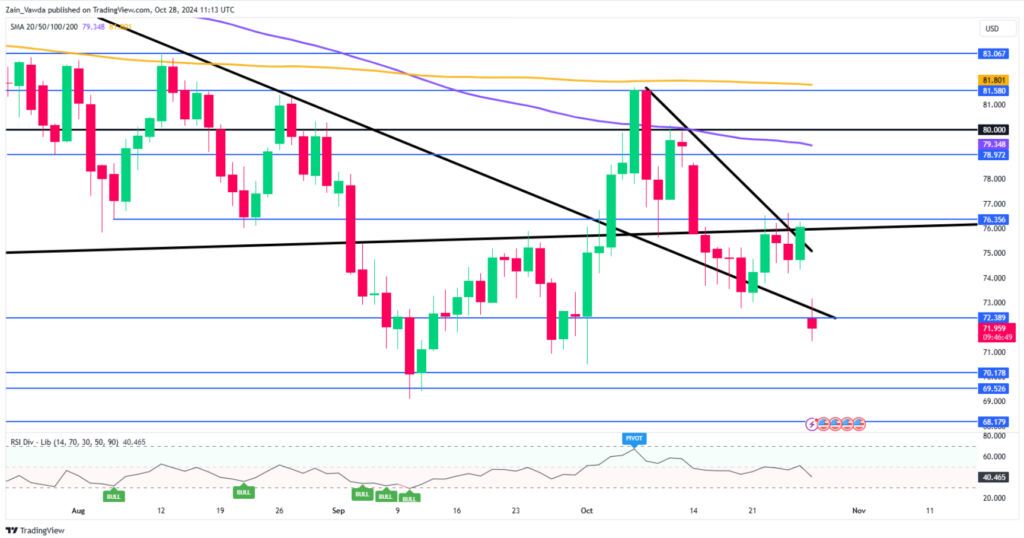Analysis: Why Oil Prices Are Likely To Stay Low After Israel’s Limited Strike
Image Source: Unsplash
For weeks the oil market had waited with bated breath for Israel’s response to Iran’s attack on Tel Aviv at the beginning of the month.
Oil prices were volatile as traders feared that Israel may target Iran’s crude oil facilities, limiting supply from the region.
However, prices plunged as much as 6% on Monday after Israel’s strike on Iran over the weekend avoided oil facilities and nuclear sites.
This makes disruption of energy supplies from Iran and the Middle East region less likely in the coming months.
At the time of writing, the price of West Texas Intermediate crude oil on New York Mercantile Exchange was at $67.94 per barrel, down 5.3%.
Brent crude on Intercontinental Exchange was down $71.81 per barrel, down 5.1% from the previous close.
Both benchmarks are at their lowest levels since earlier this month.
Israel avoids oil and nuclear sites
Israel’s pre-dawn attack on Saturday targeted several Iranian military sites, but avoided oil and nuclear sites.
Warren Patterson, head of commodities strategy at ING Group, said in a note:
The more targeted response from Israel leaves the door open for de-escalation and clearly the price action in oil this morning suggests the market is of the same view.
While it is still unclear if or how Iran may retaliate, the government has downplayed the damage caused by Israel’s response.
Iran’s Supreme Leader Al Khamenei said the attack should not be “exaggerated” or “downplayed”.
“Clearly, if we do see some de-escalation it would allow fundamentals once again to dictate price direction. And with a surplus market over 2025, this would mean that oil prices are likely to remain under pressure,” Patterson said.
Oil sell-off premature?
The limited strike by Israel over the weekend has seen the geopolitical risk premium on oil prices fade away.
But, some analysts question whether the market reaction was premature.
Zain Vawda, market analyst at OANDA, noted.
There are some analysts who share my view that a ceasefire in the Middle East is unfortunately still far away.
Even with Israel’s limited strike over the weekend, the war between Israel and Hamas in Gaza is far from over.
Moreover, Saudi Arabia, one of the top oil exporting countries in the world, has vehemently condemned Israel’s strike on Iran.
This raises concerns over a wider conflict, with one of the most powerful economies in the region joining the war.
The Middle East sits on more than half of the world’s oil reserves, making it vulnerable to any kind of escalations.
OPEC+ dilemma
Oil prices are currently far from the crucial levels of $80 per barrel. As the Organization of the Petroleum Exporting Countries and allies’ economies rely heavily on crude oil exports, the cartel wants prices above $80 per barrel, which is the breakeven level for them.
Monday’s oil price sell-off means that the OPEC+ alliance’s move to increase production from December becomes tricky.
Saudi Arabia and OPEC+ are scheduled to reverse some of their voluntary production cuts of oil from December to regain market share.
However, in the current scenario if prices continue to tumble, increasing production from December may not be in OPEC’s best interest.
At a time when non-OPEC supply has been rising and the growth is likely to outstrip demand next year, more production from OPEC may further depress crude prices.
Vawda said:
If oil prices continue to languish in the low 70’s a barrel, i think OPEC + is unlikely to raise output in December.
Technical forecast for oil prices
At the moment, analysts believe that in the absence of the geopolitical risk premiums, the support for Brent crude lies around $70 per barrel.
“Below this we have the YTD low just shy of the 69.00 to keep an eye on,” Vawda said.
“As much (as) I would love a recovery and for Oil prices to close the gap, I am not sure if we have the right conditions for that at the minute.”
(Click on image to enlarge)

Source: TradingView & MarketPulse
As for WTI prices, the support lies around $65 per barrel.
According to Fxempire.com, a move below $65 per barrel would be extremely negative.
“Middle Eastern tensions are at least starting to cool off a little bit, so maybe that helps, but really at the end of the day, the biggest concern here is going to be demand,” Christopher Lewis, author at Fxempire.com, said in a report.
More By This Author:
Ethereum Price Prediction: Risky Pattern Points To A Breakdown
Is The Coinbase Stock A Buy Or A Sell Ahead Of Its Q3 Earnings?
Can T-Mobile Shares Keep Heading Higher?
Disclosure: Invezz is a place where people can find reliable, unbiased information about finance, trading, and investing – but we do not offer financial advice and users should always ...
more



